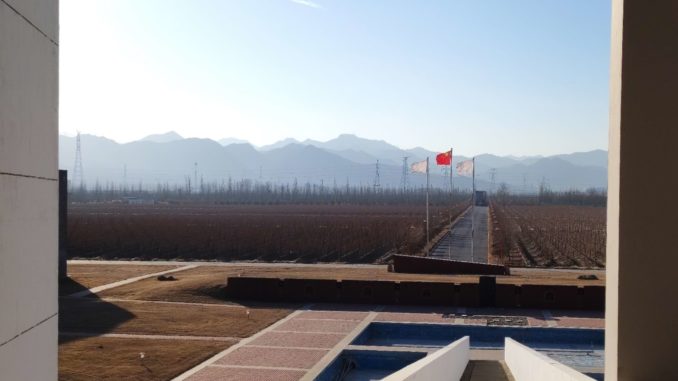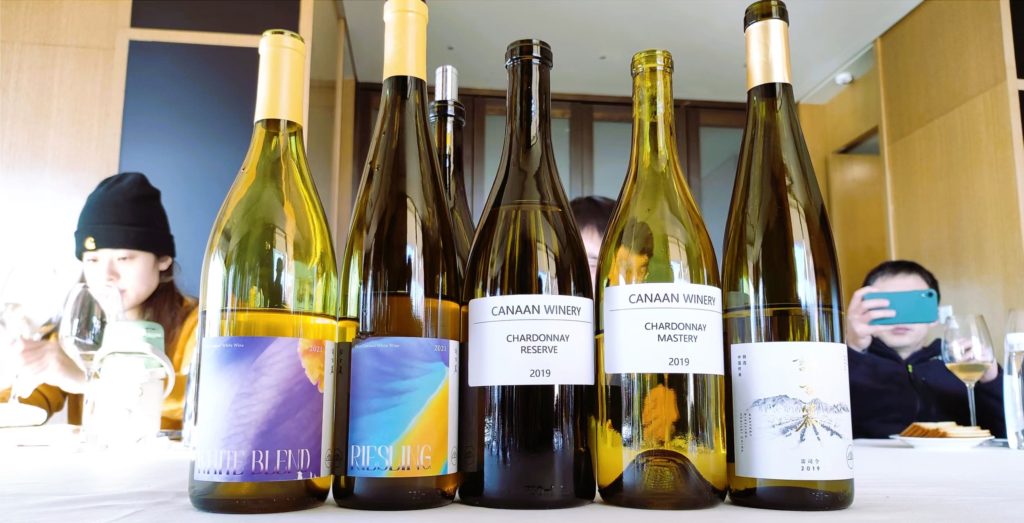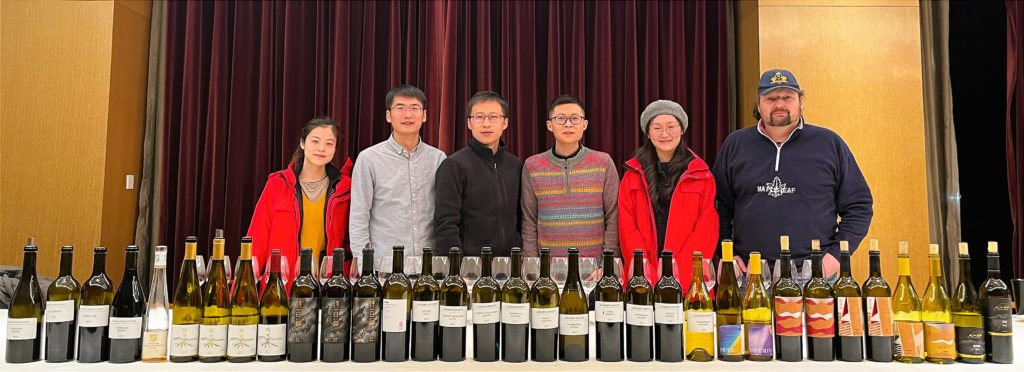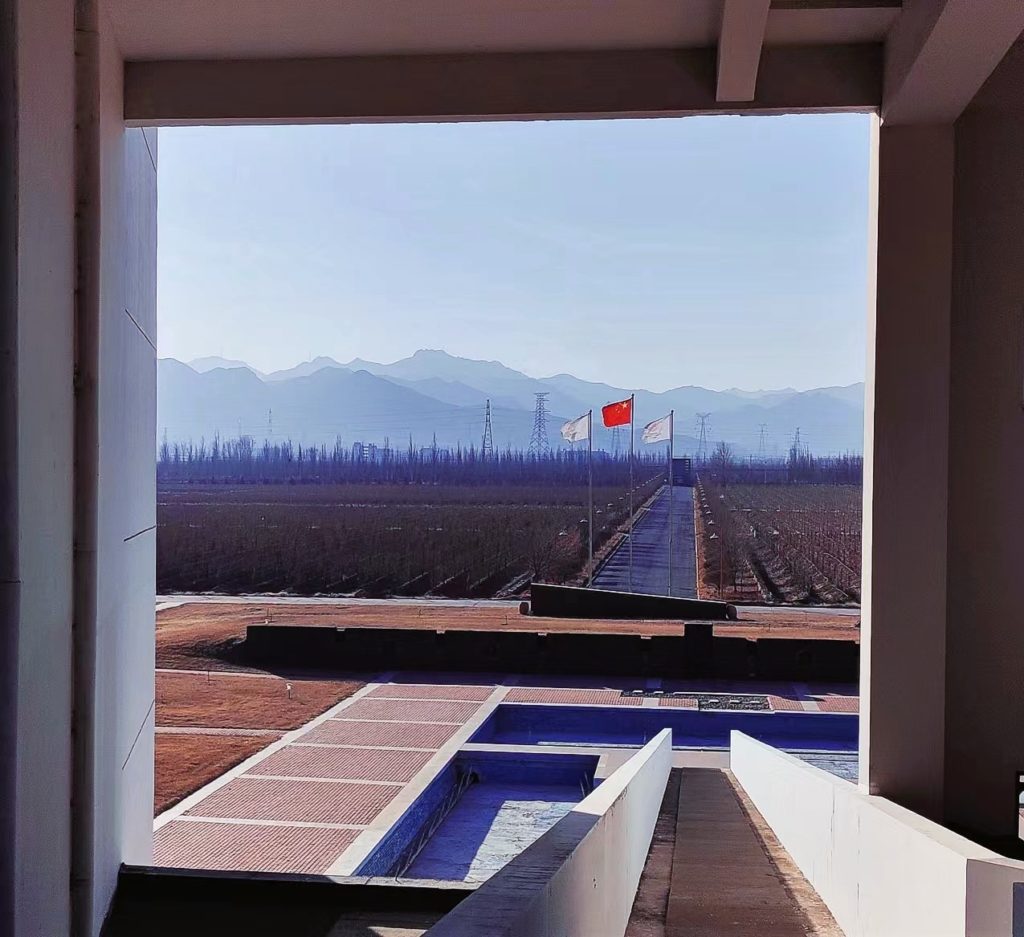
Bittersweet moment in the finger-numbing cold and flag-snapping wind at the Domaine Franco-Chinois winery near Beijing a few weeks ago. Three years earlier, I stood in the same spot and stared at the same seemingly vineless vineyards, the vines buried for winter.
I woke that January morning in one of the DFC winery’s apartments after a night of drinking ganbei style (bottoms up) with local officials and trade people. The room I slept in was nearly cold enough to see my breath (-12 Celsius outside). I felt hungover but happy.
A week earlier, I had returned to China from holidays with a mission to visit more wineries than ever and now had this adventure plus a trip to DBR Lafite’s Longdai in Shandong under my belt.

As I stood in the cold, the winery’s driver pulled up, shouted “Beijing” and raced me back to the capital. We headed toward the certainty of a coming COVID wave and the uncertainty of what that would mean. And we passed only heavy trucks—passenger cars seemed as hidden as the winery’s vines.
We all know the rest: my mission and everyone else’s was nixed as 2020 became a year of fears of the worst and hopes for the best. ‘Wash your hands for as long as it takes to sing Happy Birthday.’ ‘Don’t touch your face—or anyone else’s.’ ‘Stay six feet from people or you’ll end up six feet under.’
2021 wasn’t much better as it marked what I deemed a new Chinese zodiac sign—The Year of the Jab.
And 2022 was arguably the worst, with China mired in a “zero-COVID” battle of endless tests, travel restrictions and QR code scans. One positive case could lead to a compound lockdown or, worse, residents being sent to quarantine centers. In extreme situations, cities were quarantined for months.
The fear and hope of 2020 had turned to anger and hopelessness. But the situation suddenly and shockingly reversed in December as the COVID rules melted away while Beijing’s cold descended.

In the aftermath of that disappearing act, I tagged along with Shuai Zekun, a critic for jamesuckling.com, to visit DFC and its sibling / neighboring winery Canaan.
We tasted 39 wines with winemaker Zhao Desheng and his team. Bordeaux-style reds. Riesling with tell-tale diesel aromas. Chardonnays and Syrahs and Merlots and Marselans. A Petit Manseng with the scent of jasmine tea. Even a few skin-contact whites made from a hodge-podge of varieties, including Muller-Thurgau and Ehrenfelser.

Both Canaan and DFC are headed by entrepreneur Cher Wang. Canaan got its start in 2006 when experts, including from top US wine programs like that at UC Davis, studied sites across China to find the best ‘terroir’, ultimately picking Huailai just outside Beijing for the winery and a trio of vineyards totaling 275 hectares / 4100 mu and sitting at altitudes of 500 meters to 900 meters.
Domaine Franco-Chinois aka Zhong Fa (‘China France’) dates to the late 1990s when the Chinese and French governments started a joint venture called Sino-French Demonstration Vineyard. Over a dozen grape varieties were imported from France, including Marselan, which has spread nation-wide and is seen by some as China’s signature grape. (See my World Marselan Day project.)
Sino-French went up for sale in 2008, with suitors including importer and distributor ASC Fine Wines, although Wang ended up buying the operation and providing Canaan a sibling.
Given the investment in research, equipment and time by Canaan and DFC, it is no surprise the wines are good. While I find few a bit heavy on oak or light on acidity, none of the 39 wines we tasted stood out as faulty. They are technically well-made and generally delicious.

Among the whites, the Riesling 2019 had aromas of light diesel and Meyer’s lemon, a pleasant softness, and zingy citrus and minerality at the finish. The Mastery Chardonnay 2019 delivered crisp ripe apple character with touches of honey and white flowers: light, playful and pure, and then, after breathing a bit, taking on hints of toast and vanilla, with a sprinkle of white pepper at the finish.
We tried two skin-contact wines. The Riesling is fermented four weeks with skins in a 500-liter amphora, then aged seven months in used French barrels. Pungent: a weird but intriguing mix of chrysanthemum, diesel, passionfruit and Muscat (the tasting notes say Viognier) smells; the body was toned down, with a lemony edge.
The White Blend is a party of grapes you just don’t see in China: Muscat Blanc, Chenin Blanc, Chardonnay, Muller Thurgau and Ehrenfelser. This one sucker-punched my nose: I wrote ‘geraniums’, ‘passionfruit’, ‘floral soap’ and ‘salty’ for aromas, but that might be the booze talking. Fermented with skins in stainless steel for six weeks, it was fruitier than the Riesling, with mild tannins, and a slight spiciness and tart citrus at the finish.
These last two won’t be everyone’s cup of tea but are worthwhile for the curious and / or amber wine fans.

In general, I found the reds fresh, ripe and fruity with soft balanced tannins and some evident oak. The Merlot popped out on this day.
The ‘Sheng Tang’ Merlot 2017 had ample rich red fruit, a medium body and those soft tannins, along with an array of aromas—chocolate, cocoa, smoke—and spiciness at the finish. The ‘Yun Lu’ Merlot 2015 also had that cocoa character but more intense fruit (Bing cherry!) and a touch of tomato leaf. Big, juicy, easy-going. These wines are RMB178 and RMB340 respectively. The other Merlots were also delicious, though in some cases pricier.
I also liked the ‘Mastery’ Tempranillo 2019: a vibrant blend of dark cherry, black plum, cocoa and smoky chocolate’. Juicy, intense and fresh. The 2015 was more brooding, with dried plum alongside those hints of cocoa and chocolate. Lots going on with these wines.

And there was lots more, including intense concentrated Syrahs oozing dark fruit and brambly edges. And Pinot Noir. I made Canaan’s ‘Mastery’ Pinot Noir 2017 my first-ever million-point wine back in 2019 when I visited the winery with the team from Grace Vineyard.
This time, it stood quite delicately among all those bigger richer wines. It delivers delicious red fruits, like raspberry and yangmei, with hints of clove and vanilla. Elegant, with light tannins, and easy to drink.
As for the DFC wines, they showed well, though the star grape, Marselan, didn’t fully wake up. We should have stayed an extra day!

Our final wine, the late harvest Petit Manseng, smelled of candied apricots, white flowers and jasmine tea. I have to admit, unlike Shuai who regularly tastes 50 wines or more per day, my palate was exhausted by this point. I simply enjoyed this as a sweet treat.
And I had a flashback: DFC wines have been commercially available only the past few years, so I used to get a few bottles directly. Including in 2009, when I was best man at a Beijing wedding, and served DFC’s delectable late harvest Petit Manseng as a sweet boozy local touch. Good memories.
All in all, I felt fortunate to tag along for this tasting, hosted by winemaker Zhao Desheng and his team. And not just for the wines.
We stayed overnight in Canaan’s guest rooms, equipped with comfy beds, spacious bathrooms and views of the vineyards and mountains out back. Had meals in the staff cafeteria, with delicious local dishes, including the freshest eggs I’ve had in ages—Canaan has its own chickens. And spent time in the games room, where Shuai and Zhao put on quite the ping pong exhibition.
I also took a long walk around the winery grounds, in northern China’s vigorous January cold, and spent that bittersweet moment staring at the vineyards as I had three years ago before COVID arose and buried our plans as completely as the staff had buried the vines.
It’s been a long dark winter: hopefully our spring has now arrived.
[This was first posted in my Grape Wall of China newsletter. Also check out my posts on Instagram and Twitter.]

Sign up for the Grape Wall newsletter here. Follow Grape Wall on LinkedIn, Instagram, Facebook and Twitter. And see my sibling sites World Marselan Day, World Baijiu Day and Beijing Boyce. Grape Wall has no advertisers, so if you find the content useful, please help cover the costs via PayPal, WeChat or Alipay. Contact Grape Wall via grapewallofchina (at) gmail.com.
Leave a Reply
You must be logged in to post a comment.